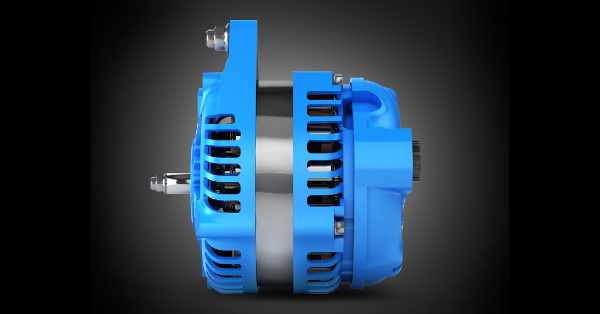It is the weekend, and as usual, you and your family are out on a road trip or shopping. You are an experienced driver, so you are confident that everything about your car is working perfectly. But then something unexpected happens. A red light appears on your dashboard, accompanied by a warning beep and a pop-up message saying check alternator. You probably have never seen this before, neither has anyone in your family.

What follows next is total panic, confusion, and stress. The big question is: if something like that ever happens to you, what would you do? The alternator is one of the most crucial parts of your car, yet not many drivers pay attention to it.
In this article, you will learn more about an alternator. We will tell you what it is, how it works, and everything else you might need to know about it.
Let’s get right into it.
- What is an Alternator?
A car uses a considerable amount of electricity to power most of the electronic components. That includes the ignition, radio, dashboard instruments, power windows, headlights, among others.
Where does all that power come from in your car?
Maybe, like most people, you think it is your battery, but that is not true.
A car battery does not have the capacity to supply such a large amount of power for long. It would drain all its charge in no time.
The alternator is the one that supplies all that power to your car’s electrical system. It is also responsible for charging your battery when it is in motion.
In simple terms, an alternator is a device designed to convert mechanical energy into electrical energy. It is a generator.
All cars have an alternator mounted on the engine except a few hybrid models.
An alternator is a maintenance-free device. It can operate for as long as 15 years without having single damage. That is one advantage it has over other devices in your car. It is also the main reason most drivers don’t think about it.
- How an Alternator Works
As mentioned earlier, an alternator converts mechanical energy into electrical energy to charge your battery and power your car’s electrical system. If you think about the magnitude, an image of a massive and complicated device is the only thing that can come into your mind.
In reality, an alternator is just a little (size of a coconut) device that works wonders in your car and is not complicated.
It relies on a few components to function:
Stator and Rotor
The rotor is a magnet, or a set of them spinning so fast inside the alternator. It serves as the spinning electromagnet.
The stator acts as the body of the alternator. It consists of a set of wire coils wound tightly around an iron ring.
The rotor and the stator work together to generate alternating current (AC).
Diode
The alternator generates AC. The electrical system in your car can only use Direct Current (DC).
The diode is the part that converts the electricity generated from AC into DC. It also ensures that current only flows in one direction, from the alternator to your car battery.
The Voltage Regulator
The voltage regulator is as the name suggests. Its work is to control or regulate the amount of power that gets to the battery from the alternator. It ensures that the voltage levels do not exceed the threshold.
You can compare the voltage regulator to a surge protector.
The Pulley
The pulley connects to the drive belt system and the rotor shaft. When you start the engine, it powers the drive belt causing a rotation to the pulley attached to the alternator. These rotations generate the electric current, which goes into the charging system.
The Cooling Fan
An alternator creates a lot of heat in the process of generating electricity. The work of the fan is to regulate the temperatures of your alternator.
- Signs of a Failing Alternator
As mentioned earlier, an alternator can last a lifetime, but that does not necessarily mean that it always will. In some instances, your alternator can develop problems and damage before its time due to the following factors,
- General wear and tear
- Overheating
- Bad diodes and other faulty parts
- Exposure to water
If your alternator is on its way out, you need to take your car to a reliable mechanic Nerang service provider for inspection and repair.
And to figure that out, below are some signs you need to watch out for
Flickering Headlights
Flickering headlights are the most obvious signs to note that your alternator has a problem. Your alternator powers the headlights when your car is running. So if your headlights are flickering or dimming, there is a good chance your alternator is not working as it should.
Dead Battery
Your alternator charges your battery when you are driving. If your alternator is working well, your battery should not die on you, especially if it is new or still in the prime of its life. If that happens, your alternator is failing.
Constant Electrical Problems
Your car’s electrical system relies on the alternator to operate.
If you keep having problems operating any electrical systems in your car, your alternator is probably on its way out.
Indicator Light
Your car should have an indicator light on the dashboard to alert you when your alternator has a problem. In this case, you will see letters ALT or GEN.
Engine Stalling
You might think that your engine runs solely on fuel, forgetting that it also relies heavily on electricity for its overall function.
To be more specific, your alternator powers the spark plug when your car is in motion. If it is failing, it means that your spark plugs will not spark as they should. As a result, the air mixture and the fuel in the combustion chamber will not ignite as they should. In the end, your engine will not have the ability to power your car appropriately. If this keeps happening, your engine will start stalling. If you are not lucky, even your car might shut down for good.
Conclusion
The engine and the alternator are the two most crucial parts of a car. They work together to maintain your car’s proper functioning, and one cannot work without the other.
As a wise driver, you need to know how your car works. That includes the engine and the alternator.




